论科技英语翻译中科学性与艺术性的和谐统一(同名27472)
浅谈英汉互译中的艺术性和科学性
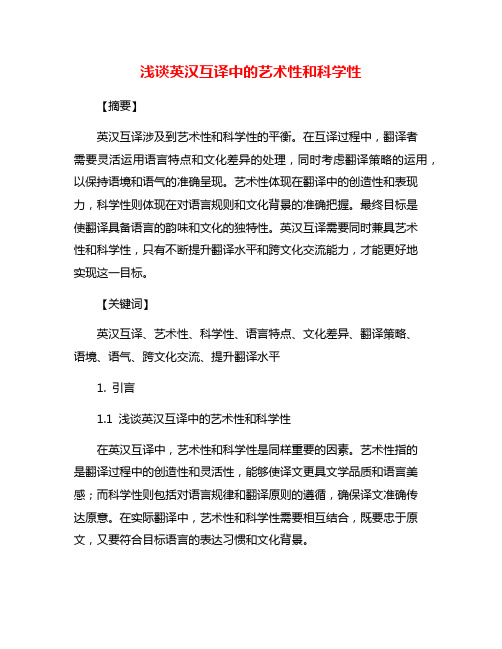
浅谈英汉互译中的艺术性和科学性【摘要】英汉互译涉及到艺术性和科学性的平衡。
在互译过程中,翻译者需要灵活运用语言特点和文化差异的处理,同时考虑翻译策略的运用,以保持语境和语气的准确呈现。
艺术性体现在翻译中的创造性和表现力,科学性则体现在对语言规则和文化背景的准确把握。
最终目标是使翻译具备语言的韵味和文化的独特性。
英汉互译需要同时兼具艺术性和科学性,只有不断提升翻译水平和跨文化交流能力,才能更好地实现这一目标。
【关键词】英汉互译、艺术性、科学性、语言特点、文化差异、翻译策略、语境、语气、跨文化交流、提升翻译水平1. 引言1.1 浅谈英汉互译中的艺术性和科学性在英汉互译中,艺术性和科学性是同样重要的因素。
艺术性指的是翻译过程中的创造性和灵活性,能够使译文更具文学品质和语言美感;而科学性则包括对语言规律和翻译原则的遵循,确保译文准确传达原意。
在实际翻译中,艺术性和科学性需要相互结合,既要忠于原文,又要符合目标语言的表达习惯和文化背景。
艺术性的体现在于翻译过程中的词语选择、句式调整和修辞手法的运用。
通过巧妙地运用语言技巧,译者可以使译文更具表现力和生动性,让读者感受到原文的美感和情感。
艺术性并不意味着胡乱发挥,译者仍需遵循翻译规范和原文语境,确保译文的准确性和通顺性。
2. 正文2.1 英汉互译的艺术性英汉互译的艺术性在翻译过程中起着至关重要的作用。
艺术性指的是翻译过程中的创造性和灵活性,通过巧妙的语言运用和转化来准确传达原文的意思,并使译文更具有文学和审美价值。
在英汉互译中,译者需要根据原文的风格、语言特点和文化背景,灵活运用各种翻译技巧和策略,以保持译文的原汁原味和表达力。
艺术性还包括译者对语言的感知和理解能力,以及对文学艺术的欣赏和把握能力。
译者需要有一定的文学修养和语言功底,能够准确捕捉原文的意义和情感,用恰当的语言表达出来。
艺术性还表现在译者对语言的创造性运用和独特见解,能够为译文增添新的意义和内涵,让读者感受到独特的美感和情感共鸣。
科学与艺术英文作文

科学与艺术英文作文英文:Science and art are two different fields, but they share some similarities. Science is concerned with discovering the truth about the world through observation, experimentation, and analysis. Art, on the other hand, is concerned with expressing emotions, ideas, and beauty through various mediums such as music, painting, and literature.Although science and art have different goals, they both require creativity and imagination. In science, creativity is needed to come up with new ideas and hypotheses, while in art, imagination is needed to create something unique and original. Both fields also require attention to detail and precision. In science, experiments must be conducted with accuracy to ensure reliable results, while in art, every brushstroke or note must be carefully chosen to convey the desired message or emotion.Furthermore, science and art can complement each other. For example, scientific discoveries can inspire artists to create new works that reflect the latest knowledge and understanding of the world. Similarly, artistic expression can help scientists communicate their findings to a wider audience and make them more accessible and understandable.In my personal experience, I have found that studying both science and art has enriched my life in many ways. Through science, I have gained a deeper understanding ofthe natural world and the forces that shape it. Through art, I have learned to appreciate the beauty and complexity of human emotions and experiences. Together, these two fields have given me a more holistic view of the world and agreater appreciation for the wonders of life.中文:科学和艺术是两个不同的领域,但它们有一些相似之处。
浅谈翻译的双重特征——翻译的科学性与艺术性

浅谈翻译的双重特征——翻译的科学性与艺术性倪娜关于翻译到底是科学,技巧,还是艺术的争论可谓旷日持久。
近些年来,机器翻译代替人工翻译的呼声越来越高,与此同时对于机器翻译的质疑之声也从未减少。
2018年博鳌论坛上的AI同传的现场效果并不完美,人工智能是否能取代同声传译,机器翻译是否能代替笔译译员耗费无数心血完成的译文,这个问题又再次被人们热议。
如果机器翻译成功了,那么证明翻译的科学性起主导作用。
但翻译学是一门经验科学,翻译经验是基石。
语言是有生命的,是不断变化的。
就目前的实践看来,机器翻译虽然一直在不断完善,但并未达到我们要求的水平。
由此证明翻译并不完全是一门科学,还需要技巧与艺术加工。
翻译到底是科学?技巧?还是艺术?这个话题一直没有定论。
但毋庸置疑的是,翻译之初就是两种语言的转换,以达到不同语言的人们之间的交流。
随着不同语言的种族之间交流的增多,人们对于翻译的要求才随之越来越高。
从传统上看,人们似乎将‘翻译’仅仅视为一种技艺,并没有将它提到‘学科’的高度。
帮助我们认识‘翻译是一门经验科学’的是哲学家,特别是20世纪30年代以来发展起来的科学哲学家。
科学哲学家使翻译研究者获得了充分的理据,提出‘翻译理论’。
1 翻译的科学性翻译出现之初,一定是经验学。
只是不同语种的人们出于交流的目的进行的两种语言上的转换。
但是在不断的实践当中,人们不断总结经验规律,制定翻译规则,归纳翻译方法。
翻译就逐渐上升到科学的高度,用于指导实践。
但翻译学又不同于其他科学学科,有具体可以量化,精确到数字的标准。
翻译学其实可以认为是社会学与人文学科的综合体,在这二者之间具有一定的不确定性与模糊性。
翻译现象不是一种简单的两种或者多种语言之间的转换行为,而是社会现象、文化现象、心智现象、精神现象与语言现象的结合。
翻译进行时需要综合考虑社会、宗教、政治、文化、教育背景等多个领域的问题,是多种因素作用下的文化产品。
可以说, 翻译学是一门独立的、开放性的、综合性的社会科学。
科技翻译科学与艺术同存
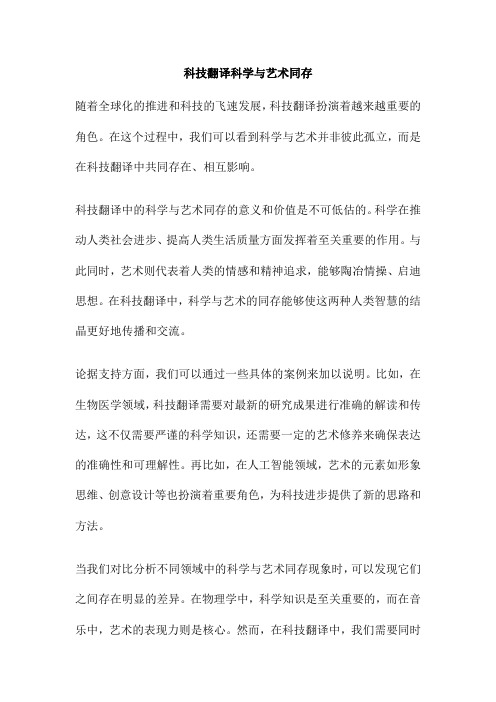
科技翻译科学与艺术同存随着全球化的推进和科技的飞速发展,科技翻译扮演着越来越重要的角色。
在这个过程中,我们可以看到科学与艺术并非彼此孤立,而是在科技翻译中共同存在、相互影响。
科技翻译中的科学与艺术同存的意义和价值是不可低估的。
科学在推动人类社会进步、提高人类生活质量方面发挥着至关重要的作用。
与此同时,艺术则代表着人类的情感和精神追求,能够陶冶情操、启迪思想。
在科技翻译中,科学与艺术的同存能够使这两种人类智慧的结晶更好地传播和交流。
论据支持方面,我们可以通过一些具体的案例来加以说明。
比如,在生物医学领域,科技翻译需要对最新的研究成果进行准确的解读和传达,这不仅需要严谨的科学知识,还需要一定的艺术修养来确保表达的准确性和可理解性。
再比如,在人工智能领域,艺术的元素如形象思维、创意设计等也扮演着重要角色,为科技进步提供了新的思路和方法。
当我们对比分析不同领域中的科学与艺术同存现象时,可以发现它们之间存在明显的差异。
在物理学中,科学知识是至关重要的,而在音乐中,艺术的表现力则是核心。
然而,在科技翻译中,我们需要同时这两个方面,以便更好地传递科技与艺术结合的价值。
历史的长河中也不乏科学与艺术同存的例子。
古希腊时期,伟大的科学家阿基米德既是著名的数学家、物理学家,又是优秀的艺术家。
他善于运用几何原理设计精美的艺术品,同时也在科学研究中展现出非凡的才华。
文艺复兴时期,众多艺术家利用科学技术创作出了令人叹为观止的杰作,如达芬奇的《最后的晚餐》等。
这些历史事实证明,在科技翻译中科学与艺术的同存具有深厚的历史根基和广泛的现实意义。
科技翻译中的科学与艺术同存不仅是一种客观现象,更是一种必然趋势。
在科技翻译中,我们需要充分认识科学与艺术同存的重要性,努力提高自己的综合素质,以便更好地传递和交流这两种人类智慧的结晶。
我们还应该积极探索科技与艺术相结合的新领域、新方法,为推动人类社会的进步和发展贡献力量。
只有在科学与艺术的共同促进下,科技翻译才能不断焕发新的活力,为人类文明的发展作出更大贡献。
科学对艺术的促进作用英语作文
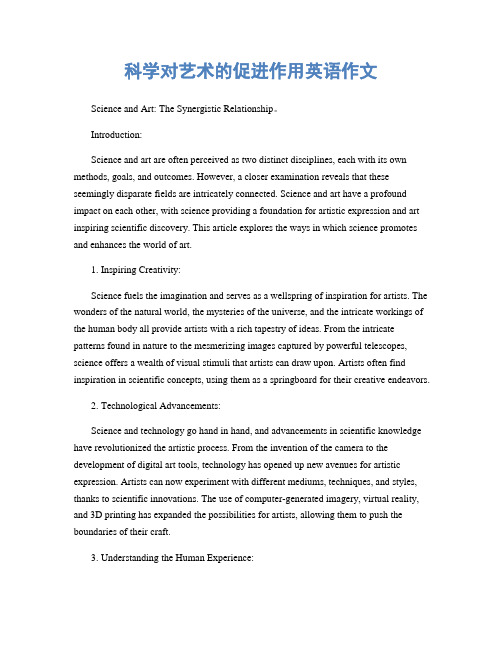
科学对艺术的促进作用英语作文Science and Art: The Synergistic Relationship。
Introduction:Science and art are often perceived as two distinct disciplines, each with its own methods, goals, and outcomes. However, a closer examination reveals that these seemingly disparate fields are intricately connected. Science and art have a profound impact on each other, with science providing a foundation for artistic expression and art inspiring scientific discovery. This article explores the ways in which science promotes and enhances the world of art.1. Inspiring Creativity:Science fuels the imagination and serves as a wellspring of inspiration for artists. The wonders of the natural world, the mysteries of the universe, and the intricate workings of the human body all provide artists with a rich tapestry of ideas. From the intricate patterns found in nature to the mesmerizing images captured by powerful telescopes, science offers a wealth of visual stimuli that artists can draw upon. Artists often find inspiration in scientific concepts, using them as a springboard for their creative endeavors.2. Technological Advancements:Science and technology go hand in hand, and advancements in scientific knowledge have revolutionized the artistic process. From the invention of the camera to the development of digital art tools, technology has opened up new avenues for artistic expression. Artists can now experiment with different mediums, techniques, and styles, thanks to scientific innovations. The use of computer-generated imagery, virtual reality, and 3D printing has expanded the possibilities for artists, allowing them to push the boundaries of their craft.3. Understanding the Human Experience:Science provides valuable insights into the human experience, which artists can then explore and portray in their work. Through scientific research, we gain a deeper understanding of emotions, cognition, perception, and the complexities of the human mind. This knowledge enables artists to delve into the depths of human emotions, capturing the essence of the human condition in their paintings, sculptures, and performances. Science helps artists to portray the intricacies of human relationships, the fragility of life, and the beauty of existence.4. Collaboration and Interdisciplinary Approaches:The intersection of science and art encourages collaboration and the exchange of ideas between individuals from different disciplines. Scientists and artists can work together to tackle complex problems, combining their unique perspectives and expertise. This interdisciplinary approach often leads to innovative solutions and groundbreaking discoveries. Collaborative projects between scientists and artists have resulted in breathtaking installations, thought-provoking exhibitions, and performances that challenge our understanding of the world.5. Communicating Science to the Masses:Art has the power to communicate complex scientific concepts to a broader audience in a visually appealing and accessible manner. Through artistic representations, scientific ideas can be conveyed in a way that is engaging and relatable. From scientific illustrations to interactive exhibits, art plays a crucial role in making science more understandable and captivating. By bridging the gap between science and the general public, art fosters a greater appreciation and interest in scientific endeavors.Conclusion:The relationship between science and art is symbiotic, with each discipline enriching and influencing the other. Science provides the foundation for artistic inspiration, technological advancements, and a deeper understanding of the human experience. Art, in turn, communicates scientific ideas, fosters creativity, and encourages collaboration. Byrecognizing and embracing the interconnectedness of science and art, we can unlock new realms of creativity, innovation, and discovery.。
科技翻译的科学性和艺术性
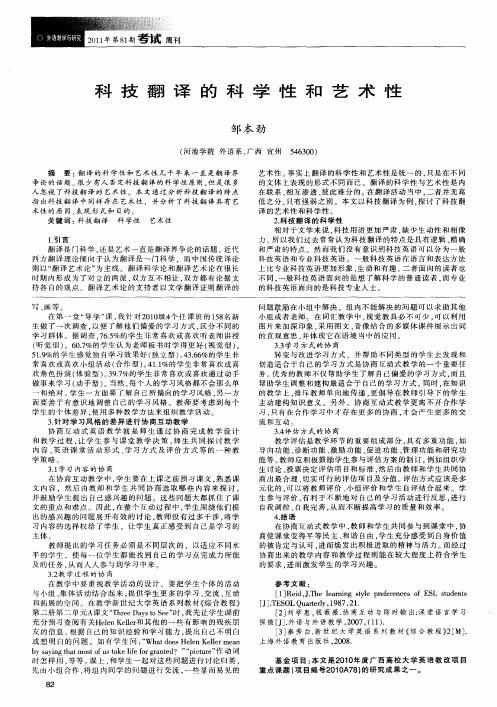
艺 术性 事 实 上 翻译 的科 学 性 和 艺 术 性 是 统~ 的 . 是 在 不 同 只 的 文体 上表 现 的形 式 不 同 而 已 。 翻译 的科 学 性 与 艺 术 性 是 内 在联 系 、 相互 渗透 、 此 难 分 的 。 翻 译 活 动 当 中 , 者 并无 高 彼 在 二 低 之分 . 有 强 弱 之 别 。 本 文 以 科 技 翻译 为 例 , 讨 了 科技 翻 只 探 译 的 艺 术性 和科 学 性 。 2科 技 翻 译 的 科 学 性 . 相 对 于文 学 来 说 , 技 用 语 更 加 严 肃 , 少 生 动性 和 相 像 科 缺 力 。 以我 们 过 去 常 常认 为科 技 翻 译 的 特 点 是 具有 逻 辑 、 确 所 精 和 严肃 的特 点 。然 而 我 们 没 有 意识 到科 技 英 语 可 以分 为 一 般 科 技英 语 和 专业 科 技 英 语 。~ 般 科 技英 语 在 语 言 和 表 达 方 法 上 比 专业 科 技 英 语 更 加 形 象 、 动 和 有 趣 。 者 面 向 的 读 者 也 生 二 不 同 , 般 科 技 英 语 面 向的 是 想 了 解 科 学 的 普 通 读 者 , 专 业 一 而 的 科 技 英语 面 向 的是 科 技 专 业 人 士 。
问 题鼓 励 在 小 组 中解 决 ,组 内不 能 解 决 的 问题 可 以 求 助 其 他
小 组 或 者 老 师 在词 汇教 学 中 . 觉 教 具 必 不 可 少 , 以 利 用 视 可 图片 来 加 深 印象 。 用 图文 、 像 结 合 的 多 媒 体 课 件 展 示 出词 采 音 的直 观 意 思 , 体 现 它 在语 境 当 中 的应 用 。 并 33 习方 式 的 协 商 .学 转 变 与 改 进 学 习 方 式 ,并 帮 助 不 同 类 型 的 学 生 去 发 现 和 创 造 适 合 于 自己 的 学 习 方 式 是 协 商 互 动 式 教 学 的一 个 重 要 任 务 。 秀 的教 师 不 仅 帮 助 学 生 了解 自己偏 爱 的 学 习方 式 , 且 优 而 帮 助 学 生 调 整 和 建构 最 适 合 于 自 己的 学 习方 式 。 时 。 知 识 同 在
艺术和科学之间的关系英语作文
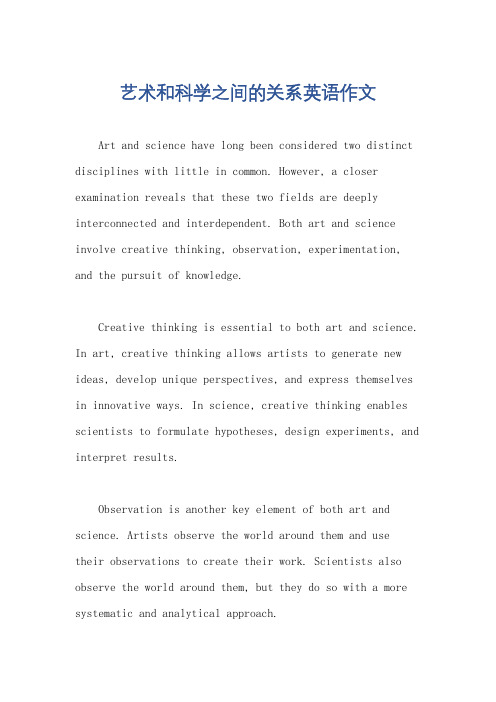
艺术和科学之间的关系英语作文Art and science have long been considered two distinct disciplines with little in common. However, a closer examination reveals that these two fields are deeply interconnected and interdependent. Both art and science involve creative thinking, observation, experimentation, and the pursuit of knowledge.Creative thinking is essential to both art and science. In art, creative thinking allows artists to generate new ideas, develop unique perspectives, and express themselves in innovative ways. In science, creative thinking enables scientists to formulate hypotheses, design experiments, and interpret results.Observation is another key element of both art and science. Artists observe the world around them and usetheir observations to create their work. Scientists also observe the world around them, but they do so with a more systematic and analytical approach.Experimentation is an important part of both art and science. In art, experimentation allows artists to explore different techniques, materials, and styles. In science, experimentation allows scientists to test hypotheses and gather data.The pursuit of knowledge is the ultimate goal of both art and science. Artists seek to understand the human condition and the world around them. Scientists seek to understand the natural world and the laws that govern it.In addition to these shared characteristics, art and science can also be used to complement each other. For example, art can be used to illustrate scientific concepts, and science can be used to inform artistic practices.There are many examples of how art and science have been used together to create powerful and meaningful works. One example is the work of Leonardo da Vinci, who was both an artist and a scientist. Da Vinci used his artisticskills to create detailed anatomical drawings that helpedto advance the field of medicine.Another example is the work of Charles Darwin, who was a scientist who used his observations of nature to develop the theory of evolution. Darwin's work was laterillustrated by artists such as Ernst Haeckel, who created beautiful and accurate drawings of the different species that Darwin had identified.The relationship between art and science is a complex and multifaceted one. However, it is clear that these two fields are deeply interconnected and interdependent. Both art and science involve creative thinking, observation, experimentation, and the pursuit of knowledge. In addition, art and science can be used to complement each other to create powerful and meaningful works.Here are some specific examples of how art and science have been combined to create innovative and groundbreaking works:The Mona Lisa by Leonardo da Vinci: This iconicpainting is not only a masterpiece of art, but it is also a testament to da Vinci's scientific knowledge. Da Vinci used his understanding of human anatomy and perspective tocreate a painting that is both realistic and aesthetically pleasing.The Theory of Relativity by Albert Einstein: This groundbreaking scientific theory was inspired by Einstein's artistic imagination. Einstein's thought experiments, in which he visualized himself traveling at the speed of light, helped him to develop the theory of relativity.The Double Helix by James Watson and Francis Crick: This discovery of the structure of DNA was made possible by the collaboration of a scientist and an artist. Watson, a scientist, and Crick, an artist, used their combined knowledge to create a model of the DNA molecule.The Large Hadron Collider at CERN: This particle accelerator is one of the most complex and ambitious scientific projects ever undertaken. However, it was also inspired by the work of artists such as Piet Mondrian andJackson Pollock. The LHC's design was influenced by the abstract paintings of these artists, which helped to visualize the complex interactions of particles within the accelerator.These are just a few examples of the many ways that art and science have been combined to create innovative and groundbreaking works. The relationship between these two fields is a complex and multifaceted one, but it is clear that they are deeply interconnected and interdependent.。
艺术与科学的交汇点的英语作文
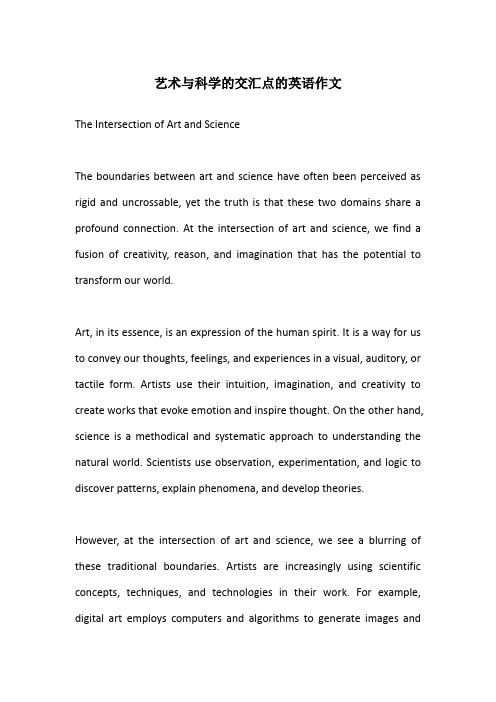
艺术与科学的交汇点的英语作文The Intersection of Art and ScienceThe boundaries between art and science have often been perceived as rigid and uncrossable, yet the truth is that these two domains share a profound connection. At the intersection of art and science, we find a fusion of creativity, reason, and imagination that has the potential to transform our world.Art, in its essence, is an expression of the human spirit. It is a way for us to convey our thoughts, feelings, and experiences in a visual, auditory, or tactile form. Artists use their intuition, imagination, and creativity to create works that evoke emotion and inspire thought. On the other hand, science is a methodical and systematic approach to understanding the natural world. Scientists use observation, experimentation, and logic to discover patterns, explain phenomena, and develop theories.However, at the intersection of art and science, we see a blurring of these traditional boundaries. Artists are increasingly using scientific concepts, techniques, and technologies in their work. For example, digital art employs computers and algorithms to generate images andsounds, while bioart explores the intersection of biology and art through the use of genetic engineering and biotechnology. Similarly, scientists are beginning to recognize the importance of creativity and imagination in their research. The field of computational creativity, for instance, explores how computers can be used to generate novel ideas and solutions.The fusion of art and science not only enriches both domains but also has the potential to solve some of the world's most pressing problems. For example, in the field of healthcare, artistic techniques can be used to design more effective medical devices and treatments, while scientific advances can provide new insights into the human body and mind. In environmental science, artistic visualizations can help us understand and appreciate the fragility of our planet, while scientific research can provide the tools and knowledge to protect it.In conclusion, the intersection of art and science is a vibrant and exciting frontier. It is a place where creativity and reason intersect, where imagination and observation converge. At this intersection, we have the potential to create new knowledge, solve complex problems, and transform our world for the better.艺术与科学的交汇点艺术与科学之间的界限常常被认为是坚硬且不可逾越的,但事实是,这两个领域之间有着深刻的联系。
艺术与科学完美结合的例子英语作文
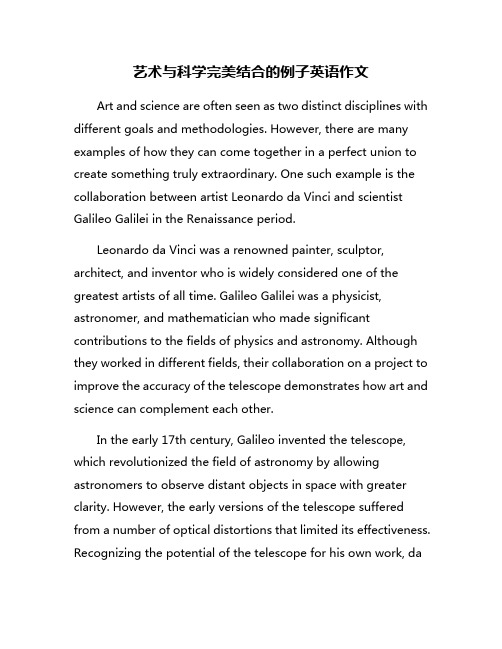
艺术与科学完美结合的例子英语作文Art and science are often seen as two distinct disciplines with different goals and methodologies. However, there are many examples of how they can come together in a perfect union to create something truly extraordinary. One such example is the collaboration between artist Leonardo da Vinci and scientist Galileo Galilei in the Renaissance period.Leonardo da Vinci was a renowned painter, sculptor, architect, and inventor who is widely considered one of the greatest artists of all time. Galileo Galilei was a physicist, astronomer, and mathematician who made significant contributions to the fields of physics and astronomy. Although they worked in different fields, their collaboration on a project to improve the accuracy of the telescope demonstrates how art and science can complement each other.In the early 17th century, Galileo invented the telescope, which revolutionized the field of astronomy by allowing astronomers to observe distant objects in space with greater clarity. However, the early versions of the telescope suffered from a number of optical distortions that limited its effectiveness. Recognizing the potential of the telescope for his own work, daVinci, who had a keen interest in optics and perspective, offered to help Galileo improve the design of the telescope.Da Vinci used his artistic skills to create precise drawings of the telescope's lenses and mirrors, which allowed Galileo to better understand how light was refracted and reflected within the instrument. By applying his knowledge of light and shadow from his painting techniques, da Vinci was able to make important suggestions for improving the shape and alignment of the lenses and mirrors to reduce optical distortions.Through their collaboration, da Vinci and Galileo were able to create a new and improved telescope that produced sharper and clearer images of celestial objects. This breakthrough not only allowed Galileo to make groundbreaking discoveries, such as the moons of Jupiter and the phases of Venus, but it also laid the foundation for future advancements in astronomy and optics.The collaboration between da Vinci and Galileo is a powerful example of how art and science can work together to achieve a common goal. Da Vinci's artistic skills and understanding of light and perspective complemented Galileo's scientific expertise in physics and optics, leading to a successful partnership that advanced the field of astronomy. By combining their talents andknowledge, they were able to push the boundaries of technology and create a tool that revolutionized our understanding of the universe.In conclusion, the collaboration between Leonardo da Vinci and Galileo Galilei serves as a compelling example of how art and science can come together to create something greater than the sum of their parts. By leveraging their respective skills and expertise, they were able to innovate and push the boundaries of knowledge in their time. This partnership exemplifies the potential for interdisciplinary collaboration to drive progress and innovation in both art and science.。
科技翻译科学性与艺术性
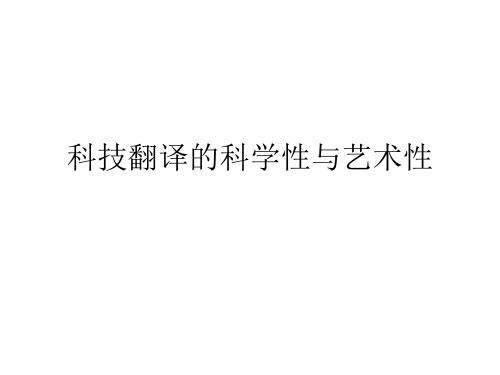
• 艺术灵活性: • 由于艺术性是译者的一个主观再创作,由 译者水平的高低决定,那么科技翻译中至 少有一定程度的灵活性或自由。例如:
• The program ready for the computer to “read” is prepared in a specially designed language. • 译文1: 提供计算机“读”的程序用专门设计的 语言编制。 • 译文2:准备给计算机“读”的程序,是用专门设 计的语言编制的。 • 两个译文都忠实传达了语义信息,但译文2在风格 表述上有点欠缺,不如译文1那样显得专业、严谨。
• 2 词义选择应避免引起歧义。科技翻译要求表达精确、严 谨因此用词要准确。特别是英语中有许多同义词,这就 要求在翻译时不但要熟悉原文所涉及的专业知识,而且还 要通晓词的基本含义与引申含义,及在特定领域中的含义。 例如: • 在正常情况下低位配置的那个阀是备用的。 • 译文:The valve positioned downward is not in use normally. • “downward”可表示向下的也可表示低位的、下面的,读者 容易产生两种理解,如按第一个解释就可理解为:朝下放 置的那个阀通常不用。与原文意思完全不同。如果把 downward改为below意思会更清楚。
注意的问题
• 要做到科学性,客观忠实与专业化需要平 时加强科技知识的学习,而且要克服由于 英汉语言差异引起的一些常见问题。应特 别注意以下3点:
• 1 注意克服汉语思维影响,例如: • 少自由度并联机器人结构简单,便于控制,成本低,在许多领域具有 广泛的应用前景,是目前机器人研究领域中的重点、热点和难点。 • 译文:Imperfect-mobility parallel robots are structural simple, ease of control and cost low. They have broad application prosperity in many fields, and are currently the key, hot and difficult spot in the robot study field. • 该译文就是按照汉语思维和表达方式逐词拼凑的。第一句中的 “structural simple”用形容词修饰形容词,不合英语语法规则。 “ ease”在这里是名词,由于该句的谓语是系动词“are”,而主语 “Imperfect-mobility parallel robots ”和表语“ease of control ”用在这 里是错误的。从句子结构上来看,两个或两个以上的句子成分在起同 一作用时,句子结构应为平行结构。“结构简单,便于控制,成本低” 却没有这样做,使句子显得比较松散。
科学和艺术的结合英语作文
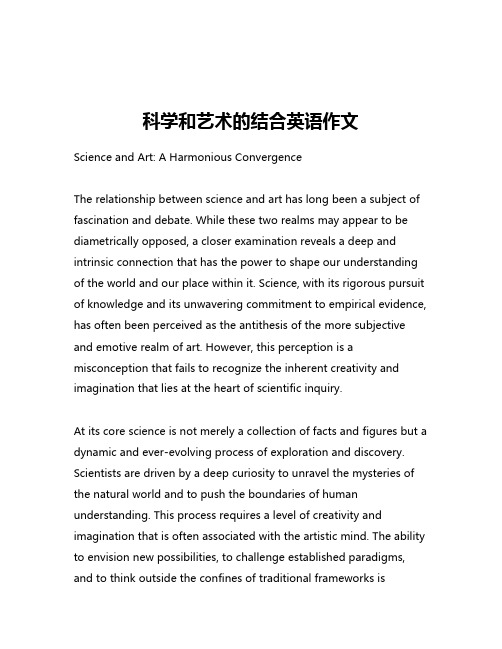
科学和艺术的结合英语作文Science and Art: A Harmonious ConvergenceThe relationship between science and art has long been a subject of fascination and debate. While these two realms may appear to be diametrically opposed, a closer examination reveals a deep and intrinsic connection that has the power to shape our understanding of the world and our place within it. Science, with its rigorous pursuit of knowledge and its unwavering commitment to empirical evidence, has often been perceived as the antithesis of the more subjective and emotive realm of art. However, this perception is a misconception that fails to recognize the inherent creativity and imagination that lies at the heart of scientific inquiry.At its core science is not merely a collection of facts and figures but a dynamic and ever-evolving process of exploration and discovery. Scientists are driven by a deep curiosity to unravel the mysteries of the natural world and to push the boundaries of human understanding. This process requires a level of creativity and imagination that is often associated with the artistic mind. The ability to envision new possibilities, to challenge established paradigms, and to think outside the confines of traditional frameworks isessential to the advancement of scientific knowledge.Similarly art in its purest form is not merely a means of self-expression but a powerful tool for interpreting and making sense of the world around us. Artists often draw inspiration from the natural world, using their unique perspectives and creative sensibilities to capture the essence of the human experience. In doing so they reveal the underlying patterns and structures that govern the natural world, providing us with a deeper understanding of the complex systems that shape our existence.The convergence of science and art can be seen in the work of many renowned figures throughout history. Leonardo da Vinci, for example, is widely regarded as the quintessential Renaissance man, seamlessly blending his scientific curiosity with his artistic talents. His meticulous anatomical studies, detailed engineering designs, and breathtaking paintings all serve as testament to the profound synergy between these two realms.In the modern era this convergence has continued to flourish with scientists and artists collaborating to push the boundaries of human knowledge and expression. Advancements in fields such as neuroscience, for instance, have provided artists with a deeper understanding of the cognitive processes that underlie the creative experience. Conversely, artists have often been instrumental invisualizing complex scientific concepts in ways that make them more accessible and engaging to the public.The benefits of this convergence extend far beyond the realms of academia and the arts. By bridging the divide between science and art, we can foster a more holistic and integrated understanding of the world around us. This understanding can inform our approach to problem-solving, decision-making, and the pursuit of sustainable solutions to the pressing challenges facing humanity.In the realm of environmental conservation, for example, the integration of scientific data and artistic expression has been instrumental in raising awareness and driving meaningful change. Artists have used their platforms to capture the beauty and fragility of the natural world, while scientists have provided the empirical evidence necessary to underscore the urgency of environmental preservation. Together, they have created a powerful narrative that has inspired individuals, communities, and policymakers to take action.Similarly, in the field of healthcare, the convergence of science and art has been instrumental in enhancing the patient experience and promoting holistic well-being. Medical professionals have increasingly recognized the therapeutic value of art-based interventions, such as music therapy and art therapy, in supportingthe physical, emotional, and psychological needs of patients. By integrating these creative modalities with evidence-based medical practices, healthcare providers can offer a more comprehensive and personalized approach to patient care.The potential for the convergence of science and art to positively impact our lives is vast and multifaceted. By embracing the synergy between these two realms, we can cultivate a deeper appreciation for the complexity and beauty of the world around us, and unlock new avenues for innovation, problem-solving, and personal growth.As we continue to navigate the challenges and uncertainties of the 21st century, the need for a holistic and integrated approach to understanding the world has never been more pressing. By bridging the divide between science and art, we can foster a more comprehensive and nuanced understanding of the human experience, and work towards a future that is both scientifically sound and artistically inspiring.。
浅议翻译的科学性与艺术性
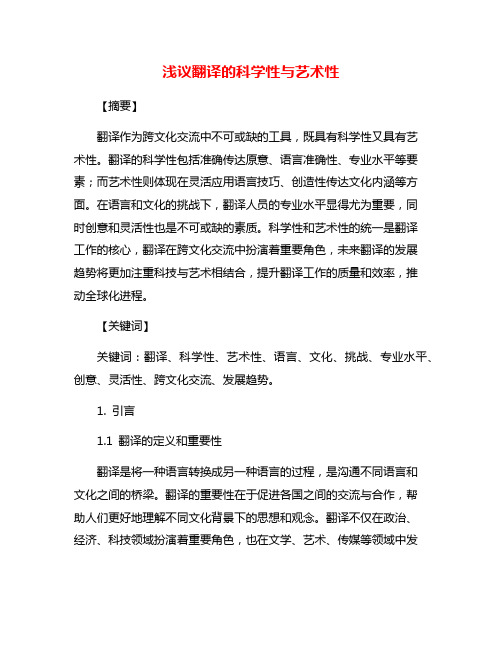
浅议翻译的科学性与艺术性【摘要】翻译作为跨文化交流中不可或缺的工具,既具有科学性又具有艺术性。
翻译的科学性包括准确传达原意、语言准确性、专业水平等要素;而艺术性则体现在灵活应用语言技巧、创造性传达文化内涵等方面。
在语言和文化的挑战下,翻译人员的专业水平显得尤为重要,同时创意和灵活性也是不可或缺的素质。
科学性和艺术性的统一是翻译工作的核心,翻译在跨文化交流中扮演着重要角色,未来翻译的发展趋势将更加注重科技与艺术相结合,提升翻译工作的质量和效率,推动全球化进程。
【关键词】关键词:翻译、科学性、艺术性、语言、文化、挑战、专业水平、创意、灵活性、跨文化交流、发展趋势。
1. 引言1.1 翻译的定义和重要性翻译是将一种语言转换成另一种语言的过程,是沟通不同语言和文化之间的桥梁。
翻译的重要性在于促进各国之间的交流与合作,帮助人们更好地理解不同文化背景下的思想和观念。
翻译不仅在政治、经济、科技领域扮演着重要角色,也在文学、艺术、传媒等领域中发挥着关键作用。
通过翻译,人们可以跨越语言障碍,分享知识和信息,推动全球化进程。
翻译的定义不仅是简单的语言转换,更包括对语言背景和文化内涵的理解和传达。
译者需要具备深厚的语言功底和文化素养,才能做好翻译工作。
翻译也需要不断学习和提升自己的专业技能,以适应不断变化的语言和文化环境。
翻译是一项既具有挑战性又充满乐趣的工作,对于促进世界各国之间的交流与理解有着深远的意义。
1.2 翻译的科学性与艺术性翻译的科学性与艺术性是翻译活动中至关重要的两个方面。
科学性指的是翻译过程中需要遵循一定的规律和方法,通过系统性的分析和处理来准确传达原文的意思。
在翻译的科学性中,包含了词语的准确性、语法结构的正确性、语境的合理性等要素。
翻译不仅仅是简单的语言转换,更需要借助语言学、语言心理学等相关学科知识,进行深入分析和解读。
与科学性相对应的是翻译的艺术性,它强调翻译过程中的创造性和灵活性。
翻译并非机械性的替换文字,而是在保持原意的基础上,根据不同语言和文化的特点,进行恰当的再现和表达。
论科技翻译的科学性及艺术性

论科技翻译的科学性及艺术性作者:吕婧史顺良来源:《校园英语·中旬》2015年第02期【摘要】随着国际之间科学技术的交流日益频繁,科技翻译受到了愈来愈多的重视。
而科技翻译的艺术性与科学性在翻译界中一直备受争论,大多数学者都承认科技翻译的科学性原则,但却忽视了科技翻译的艺术性。
本文以纽马克的交际翻译理论为框架,选取知名化妆品品牌——欧莱雅的化妆品说明书翻译为语料,通过研究语料,具体分析科学性及艺术性的表现形式,指出科技翻译具有科学性及艺术性统一的特点。
【关键词】科技翻译科学性艺术性一、引言科技英语大多用于描述事实、记录试验,阐明规律或探讨理论,因此要求科技翻译的客观性、准确性和严密性。
因此科技翻译大多是平铺直叙而很少会用到修辞手段。
即便如此,这并不意味着科技翻译不具有艺术性。
翻译的科学性和艺术性是统一而不可分割的,其区别也只是体现在不同文体中有不同形式的表现而已。
在科技翻译中,翻译的科学性与艺术性并无高低之分,其差异主要体现在程度的强弱方面。
纽马克在他所著的《翻译问题》探讨一书中提出了语义翻译和交际翻译理论的观点。
语义翻译观点强调翻译的语言和形式必须与原文本契合,其观点着重强调译文对原文在意义层面的表达,但极少关注对译文的可接受性。
而对于交际翻译理论而言,译入语读者在阅读译文时是否具有与原语读者相同的感受无疑是交际翻译理论关注的焦点。
综上所述,笔者认为纽马克的交际翻译理论所提出的语义翻译和交际翻译观点可以与科技翻译的科学性及艺术性相对应。
现将其关系总结如(图1)所示:二、科技翻译的科学性即使翻译的体裁不同,科学性都是翻译的本质属性,科技文本的目的是为了向读者传递科技信息,其翻译必须具有客观逻辑性及精确性。
本文所选语料为化妆品说明书,其大多由六部分组成:成分,使用方法,使用时的注意事项,贮存条件,产品有效期及生产批号。
考虑到化妆品的特殊性,针对其产品成分、使用时的注意事项、贮存条件、产品有效期及生产批号这四部分的翻译必须凸显其真实性及科学性。
翻译到底是科学,艺术,或科学与艺术的统一?--初步总结
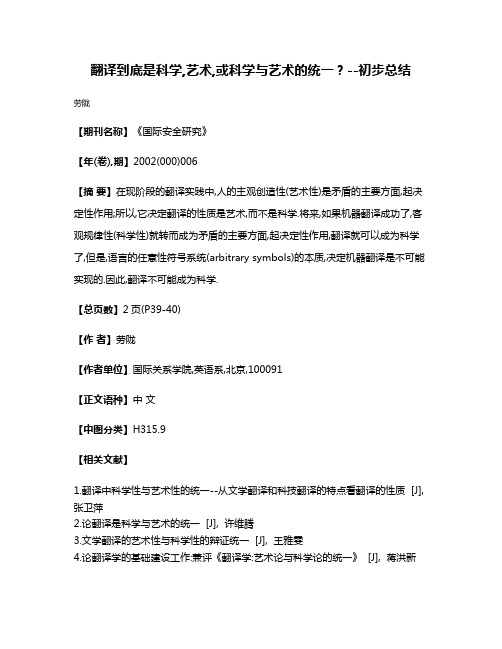
翻译到底是科学,艺术,或科学与艺术的统一?--初步总结
劳陇
【期刊名称】《国际安全研究》
【年(卷),期】2002(000)006
【摘要】在现阶段的翻译实践中,人的主观创造性(艺术性)是矛盾的主要方面,起决定性作用;所以,它决定翻译的性质是艺术,而不是科学.将来,如果机器翻译成功了,客观规律性(科学性)就转而成为矛盾的主要方面,起决定性作用,翻译就可以成为科学了,但是,语言的任意性符号系统(arbitrary symbols)的本质,决定机器翻译是不可能实现的.因此,翻译不可能成为科学.
【总页数】2页(P39-40)
【作者】劳陇
【作者单位】国际关系学院,英语系,北京,100091
【正文语种】中文
【中图分类】H315.9
【相关文献】
1.翻译中科学性与艺术性的统一--从文学翻译和科技翻译的特点看翻译的性质 [J], 张卫萍
2.论翻译是科学与艺术的统一 [J], 许维腾
3.文学翻译的艺术性与科学性的辩证统一 [J], 王雅雯
4.论翻译学的基础建设工作:兼评《翻译学:艺术论与科学论的统一》 [J], 蒋洪新
5.技术的科学基础与艺术旨向——兼论科学、技术、艺术的统一 [J], 游敏惠;谷文陶
因版权原因,仅展示原文概要,查看原文内容请购买。
科技翻译的艺术性及其艺术论
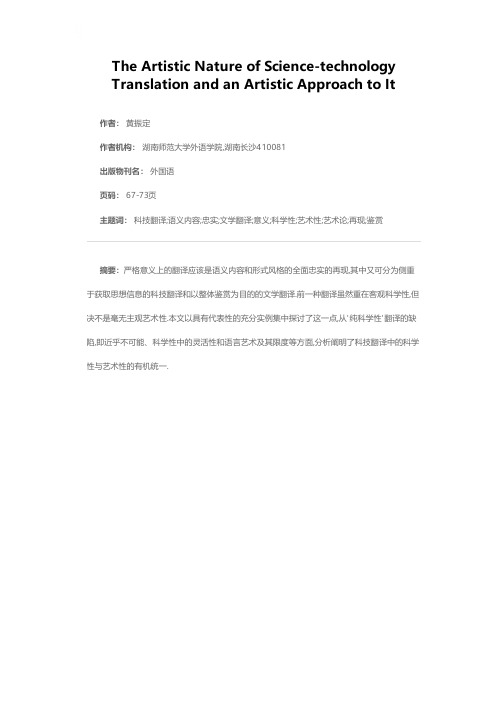
The Artistic Nature of Science-technology
Translation and an Artistic Approach to It 作者: 黄振定
作者机构: 湖南师范大学外语学院,湖南长沙410081
出版物刊名: 外国语
页码: 67-73页
主题词: 科技翻译;语义内容;忠实;文学翻译;意义;科学性;艺术性;艺术论;再现;鉴赏
摘要:严格意义上的翻译应该是语义内容和形式风格的全面忠实的再现,其中又可分为侧重于获取思想信息的科技翻译和以整体鉴赏为目的的文学翻译.前一种翻译虽然重在客观科学性,但决不是毫无主观艺术性.本文以具有代表性的充分实例集中探讨了这一点,从'纯科学性'翻译的缺陷,即近乎不可能、科学性中的灵活性和语言艺术及其限度等方面,分析阐明了科技翻译中的科学性与艺术性的有机统一.。
英语文学作品翻译的艺术性与科学性问题探析
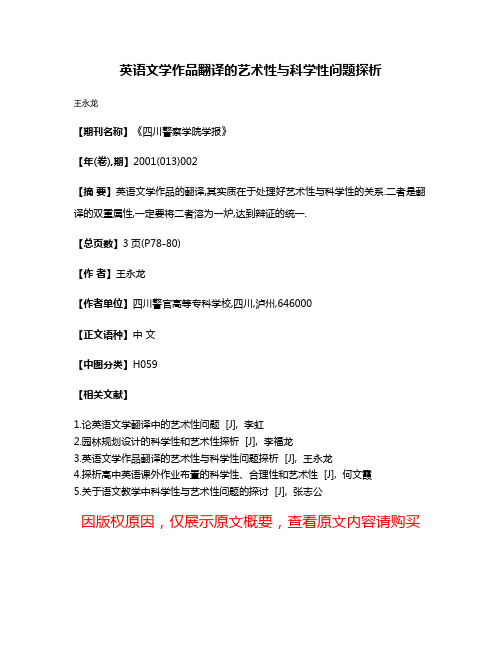
英语文学作品翻译的艺术性与科学性问题探析
王永龙
【期刊名称】《四川警察学院学报》
【年(卷),期】2001(013)002
【摘要】英语文学作品的翻译,其实质在于处理好艺术性与科学性的关系.二者是翻译的双重属性,一定要将二者溶为一炉,达到辩证的统一.
【总页数】3页(P78-80)
【作者】王永龙
【作者单位】四川警官高等专科学校,四川,泸州,646000
【正文语种】中文
【中图分类】H059
【相关文献】
1.论英语文学翻译中的艺术性问题 [J], 李虹
2.园林规划设计的科学性和艺术性探析 [J], 李福龙
3.英语文学作品翻译的艺术性与科学性问题探析 [J], 王永龙
4.探析高中英语课外作业布置的科学性、合理性和艺术性 [J], 何文霞
5.关于语文教学中科学性与艺术性问题的探讨 [J], 张志公
因版权原因,仅展示原文概要,查看原文内容请购买。
- 1、下载文档前请自行甄别文档内容的完整性,平台不提供额外的编辑、内容补充、找答案等附加服务。
- 2、"仅部分预览"的文档,不可在线预览部分如存在完整性等问题,可反馈申请退款(可完整预览的文档不适用该条件!)。
- 3、如文档侵犯您的权益,请联系客服反馈,我们会尽快为您处理(人工客服工作时间:9:00-18:30)。
论科技英语翻译中科学性与艺术性的和谐统一(同名27472)最新英语专业全英原创毕业论文,都是近期写作1 试论旅游文本英译策略2 从《永别了,武器》与《老人与海》浅析海明威的战争观3 用本我,自我,超我的弗洛伊德理论来解析《红字》4 现代人对超人的需求--超人形象演变综述5 从跨文化角度对商标名称的研究6 The Religious Thoughts in The Pilgrim’s Progress7 从文化角度探析中英基本颜色词的比较和翻译8 On the Conflicts Reflected in the Character of Rebecca Sharp in Vanity Fair9 读者与作者的断裂——多丽丝•莱辛《金色笔记》中的女权主义解读10 英语专业听力课程教学效率的调查与分析11 试谈母语对外语学习的影响12 汉英礼貌原则对比浅析13 《黑暗之心》的人性探究14 从小说《百万英镑》中看对当今社会的讽刺意义15 浅析《还乡》中游苔莎的悲剧根源16 O n Dickinson’s Choice of Nature as the Theme of Her Poems17 文档所公布均英语专业全英原创毕业论文。
原创Q 805 990 74 918 U sing Maslow’s Hierarchy Needs Theory to Analyze Sister Carrie’s Destiny19 广告语篇中的预设分析20 英汉鸟类词汇文化内涵比较21 解析《喧哗与骚动》中凯蒂悲剧的必然性22 我对直译和意译的看法23 浅析爱尔兰诗人叶芝作品中的象征主义24 T he Major Characters in Wuthering Heights under the Perspective of Ethics25 浅析儿童自然英语教学法的心理学优势26 A nalysis of the Reasons Why Jo Rejects Laurie’s Proposal of Marriage in Little Women 27 G ender Difference in Daily English Conversation28 A n Interpretation of A Tale of Two Cities from the Perspective of Symbolism29 浅析中西习俗文化“冲突”30 英汉视觉动词概念隐喻的对比研究31 T he Two Mrs.De Winters of Manderly─The comparison between “I”and Rebecca32 导入艺术在培养初中生英语学习兴趣中的运用33 《暮色》两中译本中文化缺省重构的对比研究34 论《呼啸山庄》中希斯克利夫的矛盾情感35 《紫色》女主人公性格分析36 O n the Fighting Spirit of Buck in The Call of The Wild37 对小说《野草在歌唱》的功能文体分析38 “去十九号房”中的自由观39 A nalysis of the Female Characters in Oliver Twist40 中美大学毕业典礼演讲之叙事结构的比较研究41 对《呼啸山庄》中凯瑟琳的悲剧性分析42 电影《刮痧》所体现出的文化冲突与融合43 (英语系经贸英语)解读国际知名度假村产业创新模式—以地中海俱乐部为例44 《红字》中女权主义意识探析4546 “美国梦”的幻灭——论《人与鼠》的社会悲剧47 A Comparison of English Vocabulary Learning Strategy Use in Learners of Different Ages48 浅论《洛丽塔》主人公悲剧命运的根源49 从文化角度看英语习语的翻译50 美国黑人英语在美国电影中的应用51 电影《狮子王》中象征手法的运用52 T he Tragedy of Emma In Madame Bovary53 英汉颜色词的文化象征意义及翻译54 浅析《看不见的人》中看得见的种族歧视55 T he Analysis of Promotion Strategy of L’Oréal in China56 从目的论看英文奇幻文学中专有名词的汉译57 T he Effect of Translator's Subjectivity on Creativity in English Translation of Chinese Classical Poetry58 O n Moral Characters in The Picture of Dorian Gray59 中西方传统习俗的对比研究——出生礼,婚礼,葬礼60 《论语》中“仁”的翻译研究61 (日语系毕业论文)浅谈中日饮酒艺术62 中西方文化差异63 浅析伍尔夫意识流小说中的叙事时间64 女性主义解读《威尼斯商人》中的女主角65 从节日习俗分析东西方文化差异——以春节和圣诞节为例66 英汉形状类量词的隐喻认知分析67 南北战争新思想在女性中的体现——浅析《小妇人》68 《印度之行》的象征主义分析69 英汉产品简介的对比分析70 语音歧义和语义歧义的语言学分析71 浅析英文电影在高中英语教学应用72 借代和提喻的对比研究73 浅析国际商务谈判成功之道74 论苔丝悲剧命运的根源75 从《蝇王》中的象征看人性的恶76 《哈克贝利.费恩历险记》三个中文译本的对比赏析77 高中英语新课标在xx中实施情况调查与分析78 商务英语报道中的情态意义分析79 论盖茨比悲剧的必然性80 双关语在英语广告中的应用及翻译81 O n the Translation of Chinese Dishes82 以拉康的镜像理论分析电影《法国中尉的女人》83 从人类文化语言学的角度分析英语语言中的性别歧视现象84 国际贸易中的支付方式及其风险回避85 旅游景点标志翻译初探86 汉英招呼语的对比研究87 凯瑟琳•曼斯菲尔德短篇小说中的意识流技巧研究88 初中英语语法教学之我见89 C onflicts between Chinese Culture and American Culture in The Joy Luck Club90 简爱和林黛玉的反叛性格对比分析91 英语专业学生议论文写作中连接词使用情况研究92 《觉醒》女主人公-艾德娜追求自我的过程93 A n Analysis of Barack Hussein Obam a’s Ethical Appeal and it Impact on Audiences94 T he Blacks’ Soul Under the Impact of the White Culture in The Bluest Eye95 中美大学生请求语策略对比研究96 “哈利波特”系列与儿童心理学97 论“迷惘的一代”告别“美国梦”——浅谈《永别了,武器》和《了不起的盖茨比》98 T he Glossology and Translation of Rhetorical Devices of Harry Potter99 情感因素对英语教学的影响100 美的遗失与幻灭——论托妮莫里森小说《最蓝的眼睛》中的黑人世界101 格赖斯会话合作原则与莎士比亚喜剧中的幽默解读102 索尔贝娄《挂起来的人》的存在主义解读103 浅析《老人与海》中人对自然的态度104 《名利场》的女性主义解读105 浅析奥斯丁的女性意识106 浅谈汉语成语的英译107 中西方文化差异对习语学习的影响108 非智力因素在口译中的重要性109 中美家庭教育与个人能力培养110 中西酒文化的差异对比111 奥巴马演讲词的人际意义研究112 讨论型课堂与英语学习113 论《蝇王》中人性的泯灭和救赎的无力114 Reconstructed Motherhood in Beloved115 英语报刊中的新词浅析116 中西方餐桌礼仪差异之比较117 从莎士比亚女性主义意识浅析《驯悍记》主角凯瑟琳娜118 《睡谷的传说》中理想与现实的矛盾119 从适应与选择角度看公示语翻译方法120 华盛顿•欧文与陶渊明逃遁思想对比研究121 威廉•麦克佩斯•萨克雷《名利场》的道德研究122 英语教学中的跨文化意识的培养123 数字口译及其训练策略124 A Comparison of the English Color Terms 125 从电影《国王的演讲》看平民情结126 The Revival of Benevolence Through Pip's Eyes in Great Expectations127 应对写作逻辑乱象的对策128 A Comparison of the English Color Terms 129 论商务谈判口译员的角色130 《幸存者回忆录》中多丽丝•莱辛的生态观131 The Travel of Freedom—An analysis of The Adventures of Huckleberry Finn132 从女性主义视角看《抽彩》女主角的命运133 论《呼啸山庄》中的叙述技巧134 《麦田里的守望者》中反叛精神分析135 The Interpretation to Captain Ahab in Moby Dick through Abnormal Psychology136 A Comparison of the English Color Terms 137 《乱世佳人》女主人公斯嘉丽的性格分析138 格莱斯合作原则及其对言语交际的影响139 对小妇人心灵成长历程的探索140 英语环境公示语翻译中的问题以及解决方法141 An Analysis of the Gothic Horrors in A Rose for Emily142 Angel and Devil:A Comparison Between The Two Heroes In Tess of the D’Urbervilles 143 从好莱坞电影中的中国元素看美国对中国意识观念的转变144 A Comparative Study on the Symbolic Meanings of Color Red Between The ScarletLetter and Tess of the D’Urbervilles145 An Analysis of the Stylistic Features and Pragmatic Functions of Network Language146 从礼貌原则看中英委婉语的差异147 A Brief Study of Rhetorical Devices Employed in President Obama’s Inaugural Address--from the Perspective of Syntactic Structure148 《嘉莉妹妹》与马斯洛的需求层次论149 论尤金•奥尼尔《毛猿》中的悲剧根源150 商标名的英译汉目的论研究——以洗护用品为例151 《简爱》中“愤怒”情感隐喻研究152 臻于完美的人物魅力——对简•奥斯丁《劝导》中的女主人公的分析153 Cultural Input and Syllabus in English Teaching154 论标示语汉英翻译中的等效问题155 Exploring Effective Approaches to Translating Allusion in Ancient Chinese Poetry 156 解析凯瑟琳的爱情与婚姻之分离157 从会话含义分析鲍西娅人物形象158 A Comparison of the English Color Terms 159 中美教育的比较及对比160 Saussure’s Five C ontributions to Linguistic Study and Its Modern Applications161 《威尼斯商人》中夏洛克与《失乐园》中的撒旦的反叛者形象比较162 Communicative Functions of Silence in Conversations163 英汉谚语中“爱”的情感隐喻对比研究164 试探吸血鬼文化的起源165 浅析英诗翻译的原则和方法——丁尼生《鹰》的不同译文比较166 Exploring How to Increase Students' Interest in English167 论《瓦尔登湖》的生态伦理意蕴168 《蝴蝶梦》中女主角吕蓓卡的人物形象分析169 论东西方死亡观之差异170 中英酒俗对比171 《飘》与《倾城之恋》中的女性形象对比研究172 意译在广告英语翻译中的重要性探析173 从美国影视剧中浅析委婉语的语用功能174 中西思维差异对商务谈判的影响175 An Analysis of Conflict Images in Invisible Man176 解读《献给艾米丽的一朵玫瑰花》中“玫瑰”的象征意义177 英汉习语中价值观的差异178 A Study of C-E Translation of Tourist Materials from the Perspective of Cross-culture 179 接受美学指导下的电影字幕翻译——以《冰河世纪II》为例180 英语成语跨文化翻译策略181 “邪恶的心灵”——剖析希斯克厉夫复仇的心理动机182 An Analysis of Marguerite’s Tragedy in The Lady of the Camellias183 Self-Discovery:An Analysis of Celie in The Color Purple184 双关语在日常生活中的应用185 从《红色英勇勋章》看社会突变对人的成长的影响186 中外青年婚姻观念差异——从《柳堡的故事》和《傲慢与偏见》中进行对比187 功能对等视角下记者招待会古诗词翻译策略研究188 浅析英语外加状语的语用功能189 荒诞与抵抗——《局外人》中莫尔索的荒诞表现之原因分析190 盖茨比美国梦的幻灭——透视现实生活中的爱情191 动机对中学英语学习的影响192 论科技英语翻译中科学性与艺术性的和谐统一193 论远大前程中皮普的道德观194 A Comparison of the English Color Terms 195 The Comparison of the Two Main Characters in Daniel Defoe’s Roxana and Emily Zola’s Nana196 A Study of the Personality of Emily from A Rose for Emily197 文化背景下英文电影名称的中译198 从文化角度探析中英基本颜色词的比较和翻译199 《老人与海》中的孤独200 A Comparative Study of Jane Austen andEmily Dickinson。
